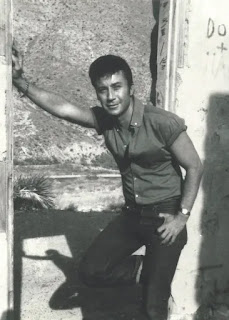cartoon in a mirror
by Douglas Messerli
Willem Elsschot Will-o’-the-Wisp in Three
Novels, translated from the Dutch by A Brotherton (Leyden, Netherlands: A.
W. Sijthoff/ London: Heinemann / New York: London House & Maxwell, 1965)
To elude further relations with the strangers, Laarmans attempts to
quickly give them simple directions. But he finds it difficult in English, the
only language he and the leader of the three, whom he as secretly named Ali
Khan, share. Instead of going left or right, one street snakes into twists and
turns, and he attempts to describe the route, accordingly, in grand gestures
that only draws a crowd to the small gathering. A local tough attempts to lead
them off to a sailor’s brothel, but after Laarmans explains where the boy plans
to take them, the visitors, sailors from the ship Delhi Castle, insist they
want only to see Maria Van Dam, and head off vaguely along the path that
Laarmans has provided.
Laarmans moves off to head home to his wife and family (we later
discover that he has six children), but while waiting for his tram encounters
them once again; and this time he becomes determined to help them find the
right address. Thus begins a voyage as surreal and comically meaningless as any
tale by Beckett.
It is apparent from the outset that they will never find the beautiful
young woman who the three men met that very morning when she visited their ship
to mend bags. So taken are the three by this beauty that they award her almost
everything they have, a scarf, a pot of ginger, and six packs of cigarettes.
She, in turn, reciprocates with her name and address scrawled on the piece of
cardboard they carry. But the search, spurred on by the slightly selfish and
secretly bigoted kindnesses of Elsschot’s Flemish fool, is everything, for the
journey tells us much more about these four men than any possible resolution.
Despite the constant paternalism of Laarmans and his inner feelings that
the "Indians" can comprehend little that his culture puts before
them, it is the Flemish “leader,” if you can call him that, who is utterly
confused, so desperate in his own married and bourgeois life that he imagines
even this tawdry encounter between three men and one woman to be an exciting
adventure. It is he, not the three “foreigners” who imagines that the young
girl might be underage, fourteen or even younger. Ali and his friends are quite
shocked; no, the woman they seek is in her 20s. Laarmans justifies his
imaginative slip as part and parcel of his general disdain of his own country’s
values and religion. He is the kind of small-minded burgher who refuses to see
himself as a sexual prude. But the men who follow him are, we later discover,
as moral as they can be. They, so they later tell him, are not from India, but
from Afghanistan, loyal Muslims who are totally immersed in their religion and
cultural values, and who later chastise Laarmans for his drinking.
Yet, their very appearance in this world of blondes leads them into
danger. The first address they visit sells bird cages, empty cages that lock
away not only animals, but, symbolically, the sons and daughters of the Flemish
merchants. Laarmans and his Afghani charges cannot help but wonder whether the
old woman at the counter and her young brute of a son are hiding Maria in a
back room.
The second of their visitations leads directly to the police station, a
notorious place of lock-up obviously
dangerous to these strangers, aware of the racial restrictions of the culture;
they will not even enter. Laarmans takes over, prying information from the fat
officer at the front desk. But even though they wait outside this gigantic
cage, Ali is captured and brought inside to be charged for a nonexistent crime.
Without Laarmans' identification of his friend, he would surely have been
incarcerated.
Their final destination is also a kind of prison warren, a dilapidated
hotel used partially, it is apparent, as a brothel. Here both customers and
clients are locked away in tawdry little rooms where the bartender-owner warns
that some of its registered denizens have been dead for years.
Through this strange night voyage, the three Afghani men behave with the
greatest of grace and honor, while the Flemish citizens, even the obsequious
Laarmans, dismiss, doubt, and threaten the holy trio on their search for their
own Mary. These three strangely wise men do finally find, in the wretched
hotel, their mother and child, but when they attempt to award her the flowers
they have purchased for Maria, she merely snarls.
As they return to their ship, the exhausted Laarmans heads home,
suddenly realizing the brutal irony that the object of their search likely was,
after all, to be found in the brothel where the butcher’s boy originally had
intended to take them. Their dream, this likeable fool now comprehends, is far
superior to the utter and endlessly boring ties that bind him. The cartoon
image with which the book seems to have began has been mirrored back unto the
society which created it.
Antwerp, June 2, 2010
Reprinted from EXPLORINGfictions (July 2010).






